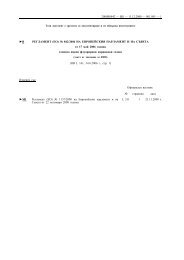Програма на научната конференция - Министерство на ...
Програма на научната конференция - Министерство на ...
Програма на научната конференция - Министерство на ...
- No tags were found...
You also want an ePaper? Increase the reach of your titles
YUMPU automatically turns print PDFs into web optimized ePapers that Google loves.
The infections were found in the gut (nematodes, gregarines, microsporidia),gonads (microsporidia) and haemolymph (nematodes) of the infected insects.Protozoan species (Gregarinida) were detected in six bark beetle species(Pityogenes bistridentatus, P. chalcographus, P. conjunctus, Ips sexdentatus,Orthotomicus proximus, Taphrorychus villifrons). The prevalence of the gregarinesvaried between 0.3% and 75%. Microsporidia of the genus Nosema andChytridiopsis were revealed in three bark beetle species (Hylurgus ligniperda, Ipsacuminatus, Taphrorychus villifrons). The prevalence of the microsporidia rangedbetween 1% and 10%. This is the first report of a microsporidium in T. villifronsand of gregarines in P. conjunctus and T. villifrons. The fungus Beauveriabassiana was found in 11% of Hylurgops palliatus specimens. Nematodes (in gutand haemolymph) were revealed in seventeen bark beetle species and theirprevalence varied between 17% and 97%.17:45-18:00REVEALING BIODIVERSITY: WHAT OPOSSUM SHRIMPS(MYSIDACEA) CAN LEARN US?M. JocqueCentral Laboratory of General Ecology, Bulgarian Academy of Sciences,2 Gagarin Street, 1113 Sofia, BulgariaIn a time characterized by a global biodiversity crisis and large-scale climatechange there is an accentuation of concern for the environment and the recognitionthat we need to know the resources present in order to protect them. We present therecording of biodiversity over time for the Mysidacea, a group of mainly marineCrustacea with a global distribution. They have a pelagic and occasionally abenthic ecology, and make up an important part of food chains, mostly as food forfish. Currently 1099 species are recognized (Anderson 2008). The number ofspecies described each year since the publication of the first species description in1776 (Praunus flexuosus Müller) has increased exponentially. At this point thereare no indications that a plateau in the cumulative species-curve will be reachedsoon. We are nowhere close to knowing this group or even predicting the totalnumber of species and similar trends are observed in other groups. Unless theinventory of a group is nearly complete, estimating the total number of species isassociated with very large margins of error due to variations in the discoveryprocess. Essential variables are invested effort (e.g. number of scientists) and thegeographic distribution of attention. If we want to document the remainingdiversity of life on this globe before it disappears we need well coordinated (large)international projects focusing on biodiversity high and understudied areas.41
















